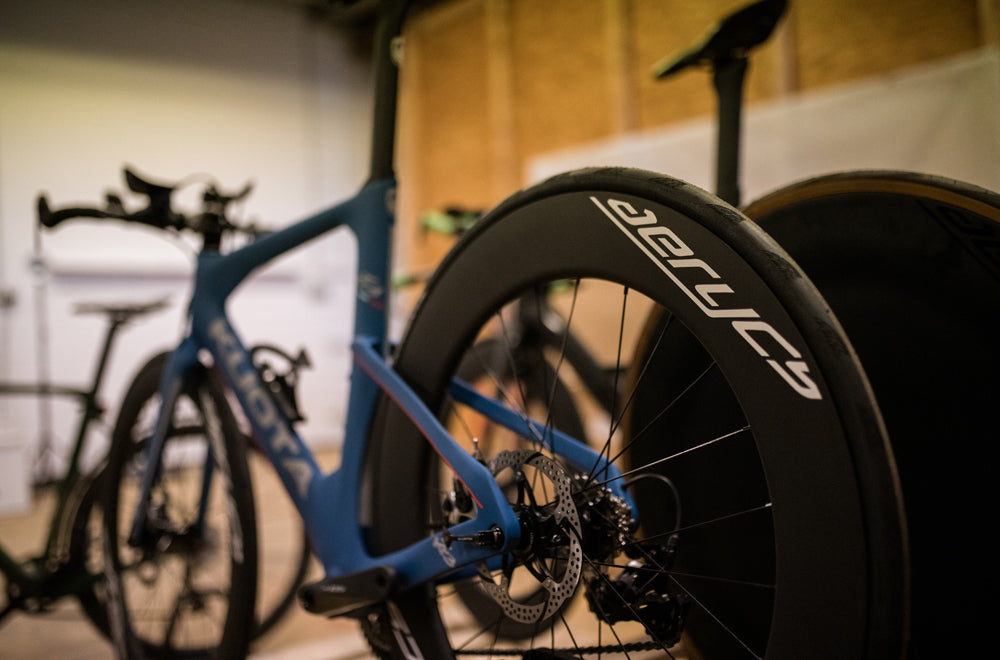Our wheels are assembled by hand in the Hamburg area. How carefully these components are selected and combined with each other determines the durability of the wheel. Today there are a lot of good ready-made wheels or system wheels to buy, which is why not every dealer builds them himself anymore. System wheels are available in light, stiff, robust or inexpensive versions. However, they are often characterised by the use of manufacturer-specific components. In the event of a defect, you have to rely on the specific component and you don't always get the spare parts if the purchase was made several years ago. If you have your customised wheel built by us, you can tailor it to your needs and be sure that we can provide you with a replacement in case of a defect.
We start in this article with the spoke: the function of the component, the number of spokes as well as the spoke types and the Spoke layout.
The spokes are connected to the rim and attached to the hub shell. Due to the high pretension, tensile forces are transmitted between the rim and the hub. The wheel works permanently under load - i.e. when riding. The weight of the rider together with that of the wheel is distributed via the hub to the upper spokes, while the lower spokes are relieved accordingly when riding. Spokes are the most resilient part of the bicycle and are usually made of steel. Spokes made of aluminium, titanium, carbon or textile fibres are also available.
You have probably noticed that there are wheels with different numbers of spokes. This varies depending on the type and use of the bicycle. For example, everyday bikes often have 32 or 36 spokes, while racing bikes sometimes have 16, 18 or 20. The most common are 24, 28, 32 and 36 spokes, with 24 spokes being the most popular on road bikes. You can get 16, 20, 24 or 28 spokes on a wheel, according to the wheel and your wishes. The number of spokes does not necessarily indicate stability or weight.
Due to the constantly changing tension of the spokes when riding, too little or uneven spoke tension can lead to upward or lateral impacts. As a result, spoke cracks can occur.


A distinction is made between straight-pull spokes and cranked spokes, also known as J-bends. In terms of quality, there is little difference between the two types.
Offset spokes are the conventional spokes with a curved end and a flat spoke head. The other end of the J-bend spoke has a thread onto which the nipple is screwed.
Straight-pull spokes, unlike the J-bend spoke, do not have a bend and resemble a screw due to their appearance.
Knife spokes are flat pressed round spokes in aero form. They have improved drive and braking stiffness because the spokes installed longitudinally to the drive or braking direction are much more difficult to deform than a round spoke.
Compared to the knife spoke, round spokes require much less material, because the rolled knife spoke requires more material for the transition.


When guiding spokes on wheels, a distinction is made between crossed and radial spokes.
Crossed spokes mean that they run crosswise from the hub to the rim. On mountain bikes, spokes are often triple crossed, which means that each spoke crosses three opposing spokes between the hub and the rim. Double crossings are also often used Spoke layout. But five-way crossings are also possible.
Radial Spoke layout refers to spokes that run directly to the rim without crossing. Road bikes often have a combination of both lacing systems to give the wheel optimum stability and elasticity. In this case, the front wheels are often spoked radially and the rear wheels crossed, as the rear wheel bears about two thirds of the weight. In general, the more spokes a wheel needs, the more often they have to be crossed.


The nipple is screwed onto the spoke by inserting it from the outside through the rim onto the spoke. As a rule, nipples are made of brass or aluminium. Longer spoke nipples provide more grip than shorter spokes due to the longer thread and are often fitted with a washer.
DT Swiss Aero Comp
A balance between stiffness, aerodynamics and durability.


DT Swiss Aerolite
The lightest flat spoke with high stability and very good aerodynamics.


Sapim Strong
Wie der Name schon verrät – eine sehr starke Speiche.
Nippel
14mm SAPIM Nippel // Vier oder Sechskant


In our shop we have already put together a selection of hand-built wheels for you. Are you unsure which spoke is the right one for you and your bike?
No problem, we are happy to advise you. Simply contact us via our Contact form contact.




